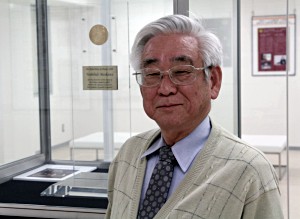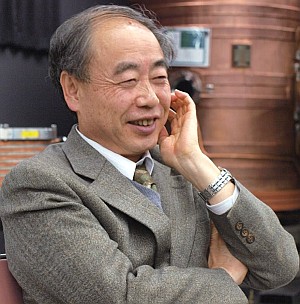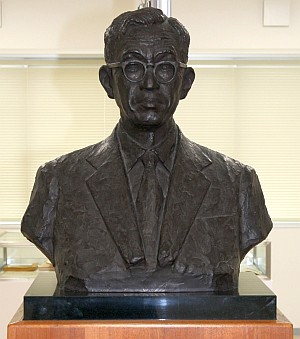Features
Features
Life, the Universe and Everything
- ツイート
- 2010/06/24
The Kobayashi-Maskawa Institute for the Origin of Particles and the Universe (KMI), a major new research institute for the study of particle physics, theoretical and observational astrophysics and cosmology at Nagoya University, was officially opened in April 2010.

The KMI, currently comprising a combined research center and exhibition hall housed in newly refurbished premises in the Faculty of Science at Nagoya University, was created in recognition of the achievements of two distinguished Nagoya University alumni, Makoto Kobayashi and Toshihide Maskawa, who along with Yoichi Nambu of the University of Chicago were awarded the 2008 Nobel Prize in Physics. Officially opened in April 2010 and financed by a combination of external funds and support from Nagoya University, the KMI is still undergoing development and will eventually occupy an additional two floors in a purpose-built facility on an adjacent site currently under construction and scheduled for completion in April 2011.
The KMI is led by Maskawa as its director general in close collaboration with Kobayashi who serves as the chair of the KMI scientific policy committee and as an advisor for the institute. Their work at the institute is a continuation of their long scientific association that began at Nagoya University where both men earned their doctoral degrees under the direction of the late legendary Shoichi Sakata, who proposed the eponymous model of elementary particles that preceded the quark model. From there the two moved to nearby Kyoto University shortly before publishing their landmark paper entitled "CP Violation in the Renormalizable Theory of Weak Interaction" in 1973.

Speaking to Nagoya University Research, Maskawa, who is also professor emeritus at Kyoto University and a professor of Kyoto Sangyo University, laid out a forward-looking, open and inclusive vision for the new facility and its staff, while stressing that the KMI was still in its early stages and that the exact nature of its mission was not set in stone. "The most important thing is that the people we have gathered here [in the KMI] produce results in line with the objectives of the institute," he says. "In particular, we want to gather as many top-class researchers in the institute as possible, and we want to welcome people who will visit and stay with us for a while, helping us to broaden and deepen our research...as a theorist, I know that the most important thing is to have the ability and room for discussion. I would like to build an environment where that is possible."
The KMI is an entirely research-based organization and does not offer undergraduate courses, although many of its staff members carry out teaching duties in a personal capacity in other parts of Nagoya University. Research activities are divided into two sections: The Center for Theoretical Studies and the Center for Experimental Studies. Amongst the topics covered at the KMI, particular emphasis is laid on computational theoretical physics; the institute is actively recruiting young, talented researchers who are capable of flourishing in the 24/7 world of modern computational science. "After all, computation is not really something that should be left up to old men like me," laughs Maskawa, who celebrated his 70th birthday in February. Experimental particle physics is not neglected however, with staff from the KMI being actively involved in high-profile national and international projects at facilities such as the Large Hadron Collider at the European Organization for Nuclear Research (CERN) in Geneva, Switzerland, and the beam lines at the High Energy Accelerator Research Organization (KEK) in Tsukuba, Japan.
Although some areas of special interest have been identified, Maskawa admits that the overall direction of research at the institute is still a work in progress that is deliberately being allowed to find its own path. "At the beginning we didn't sit down with a blank sheet of paper and dream up a complete organizational framework and then go out and try to make it happen. We're looking at what we have and what results come out of our current work with a view to expanding what we can do as we go forward," he says. "Our plan at the moment is to staff the KMI with domestic hires, focusing particularly on researchers from Nagoya University and bit-by-bit accumulate a portfolio of work. Using this as a base we will then be in a position to start inviting overseas researchers to the KMI initially as visitors."

The task of defining the mission of the KMI will rest then in part on its current 29 staff, whose numbers are soon to be boosted to over 35 by a rash of new appointments -- all of whom are expected to come from top Japanese universities. Although the approach to developing formal external links is to be a gradual one, Maskawa hopes that, in addition to establishing global ties with other nations that will benefit the KMI internationally, the institute will help to raise the level of high-energy physics research in the Asia-Pacific as a whole by assisting other countries in the region to expand their own research programs.
In all these things, Maskawa is keen to continue in the traditions of Shoichi Sakata, who was affectionately nicknamed Bonji by his students after a humble, undemonstrative cartoon character popular in post-war Japan. Invoking one of his former mentor's favorite sayings, Maskawa stresses both the intellectual rigor and mutual encouragement required for top-level science: "As long as you have the best philosophy and the best organization, anyone can do good physics."
Looking at the positive start that the Kobayashi-Maskawa Institute has made, no doubt Bonji would have been proud.
NU Research
(English)

